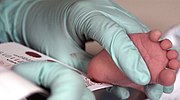|
How Rare is PKU?
Phenylketonuria (PKU) occurs in about 1\10,000--15,000 caucasion or oriental births. PKU
happens much less often in African Americans. In some interbreeding societies, though, it can occur in about 1\125 births. The disease occurs equally in males and females.
How is the Disease Passed On?
PKU is an autosomal recessive disorder. This means that each parent has one mutated gene for the
disorder, but doesn't express the symptoms. The child will have PKU when both parents pass on their mutated
gene to their offspring.

What Are the Symptoms?
Untreated
Infant Phenylketonuria Symptoms:
Untreated
Matured Phenylketonuria Symptoms:
How is PKU
treated?
Newborn testing
for Phenylketonuria is the best key for effective treatment. Newborn screening began in the 1960's. As of
2004, urine and blood testing for PKU in newborns is given in every state in the United States along with many other countries.
PKU is treated by a special diet of foods containing only enough proteins to satisfy the amount of phenylalanine that is needed
for proper growth and development. Food in this diet include fruits, vegetables, and some grains and cereals.
A synthetic formula provides for the remaining phenylalanine. If treated, the affected individual will live a normal
life, but it left untreated, the individual will suffer from severe mental retardation and could suffer from seizures.
These resulting symptoms could be fatal.

A newborn's blood is tested for PKU.
How can I help?
The National
Society for Phenylketonuria (NSPKU) is asking for your generosity to make donations to help treat and promote care for people
with phenylketonuria. Donations are taken securely online at the website www.justgiving.com/nspku/raisemoney/. This website allows anyone to make a specific fundraising page for their loved one with phenylketonuria.
This link (http://www.justgiving.com/deborahcasale) is a fundraising page for Phoebe Casale, who suffers from Phenylketonuria. Or, if you want to raise awareness
for Phoebe Casale, simply copy the following code into your blog, webpage, or myspace account.
<object
type="application/x-shockwave-flash" allowScriptAccess="always" allowNetworking="all" height="230" width="150" align="middle"
data="http://www.justgiving.com/widgets/jgwidget.swf" flashvars="EggId=904313&IsMS=0"><param name="movie" value="http://www.justgiving.com/widgets/jgwidget.swf" /><param name="allowScriptAccess" value="always" /><param name="allowNetworking" value="all" /><param
name="quality" value="high" /><param name="wmode" value="transparent" /><param name="flashvars" value="EggId=904313&IsMS=0"
/><param name="bgcolor" value="#ffffff" /></object>
Credits
*Information
taken from:
*Images
taken from wikipedia.org
|

